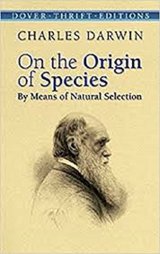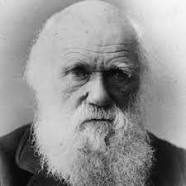On the Origin of Species By Means of Natural Selection Page #13
On the Origin of Species, published on 24 November 1859, is a work of scientific literature by Charles Darwin which is considered to be the foundation of evolutionary biology. Darwin's book introduced the scientific theory that populations evolve over the course of generations through a process of natural selection.
There is one point connected with individual differences, which seems to me extremely perplexing: I refer to those genera which have sometimes been called "protean" or "polymorphic," in which the species present an inordinate amount of variation; and hardly two naturalists can agree which forms to rank as species and which as varieties. We may instance Rubus, Rosa, and Hieracium amongst plants, several genera of insects, and several genera of Brachiopod shells. In most polymorphic genera some of the species have fixed and definite characters. Genera which are polymorphic in one country seem to be, with some few exceptions, polymorphic in other countries, and likewise, judging from Brachiopod shells, at former periods of time. These facts seem to be very perplexing, for they seem to show that this kind of variability is independent of the conditions of life. I am inclined to suspect that we see in these polymorphic genera variations in points of structure which are of no service or disservice to the species, and which consequently have not been seized on and rendered definite by natural selection, as hereafter will be explained. Those forms which possess in some considerable degree the character of species, but which are so closely similar to some other forms, or are so closely linked to them by intermediate gradations, that naturalists do not like to rank them as distinct species, are in several respects the most important for us. We have every reason to believe that many of these doubtful and closely-allied forms have permanently retained their characters in their own country for a long time; for as long, as far as we know, as have good and true species. Practically, when a naturalist can unite two forms together by others having intermediate characters, he treats the one as a variety of the other, ranking the most common, but sometimes the one first described, as the species, and the other as the variety. But cases of great difficulty, which I will not here enumerate, sometimes occur in deciding whether or not to rank one form as a variety of another, even when they are closely connected by intermediate links; nor will the commonly-assumed hybrid nature of the intermediate links always remove the difficulty. In very many cases, however, one form is ranked as a variety of another, not because the intermediate links have actually been found, but because analogy leads the observer to suppose either that they do now somewhere exist, or may formerly have existed; and here a wide door for the entry of doubt and conjecture is opened. Hence, in determining whether a form should be ranked as a species or a variety, the opinion of naturalists having sound judgment and wide experience seems the only guide to follow. We must, however, in many cases, decide by a majority of naturalists, for few well-marked and well-known varieties can be named which have not been ranked as species by at least some competent judges. That varieties of this doubtful nature are far from uncommon cannot be disputed. Compare the several floras of Great Britain, of France or of the United States, drawn up by different botanists, and see what a surprising number of forms have been ranked by one botanist as good species, and by another as mere varieties. Mr. H. C. Watson, to whom I lie under deep obligation for assistance of all kinds, has marked for me 182 British plants, which are generally considered as varieties, but which have all been ranked by botanists as species; and in making this list he has omitted many trifling varieties, but which nevertheless have been ranked by some botanists as species, and he has entirely omitted several highly polymorphic genera. Under genera, including the most polymorphic forms, Mr. Babington gives 251 species, whereas Mr. Bentham gives only 112,--a difference of 139 doubtful forms! Amongst animals which unite for each birth, and which are highly locomotive, doubtful forms, ranked by one zoologist as a species and by another as a variety, can rarely be found within the same country, but are common in separated areas. How many of those birds and insects in North America and Europe, which differ very slightly from each other, have been ranked by one eminent naturalist as undoubted species, and by another as varieties, or, as they are often called, as geographical races! Many years ago, when comparing, and seeing others compare, the birds from the separate islands of the Galapagos Archipelago, both one with another, and with those from the American mainland, I was much struck how entirely vague and arbitrary is the distinction between species and varieties. On the islets of the little Madeira group there are many insects which are characterized as varieties in Mr. Wollaston's admirable work, but which it cannot be doubted would be ranked as distinct species by many entomologists. Even Ireland has a few animals, now generally regarded as varieties, but which have been ranked as species by some zoologists. Several most experienced ornithologists consider our British red grouse as only a strongly-marked race of a Norwegian species, whereas the greater number rank it as an undoubted species peculiar to Great Britain. A wide distance between the homes of two doubtful forms leads many naturalists to rank both as distinct species; but what distance, it has been well asked, will suffice? if that between America and Europe is ample, will that between the Continent and the Azores, or Madeira, or the Canaries, or Ireland, be sufficient? It must be admitted that many forms, considered by highly-competent judges as varieties, have so perfectly the character of species that they are ranked by other highly-competent judges as good and true species. But to discuss whether they are rightly called species or varieties, before any definition of these terms has been generally accepted, is vainly to beat the air. Many of the cases of strongly-marked varieties or doubtful species well deserve consideration; for several interesting lines of argument, from geographical distribution, analogical variation, hybridism, etc., have been brought to bear on the attempt to determine their rank. I will here give only a single instance,--the well-known one of the primrose and cowslip, or Primula veris and elatior. These plants differ considerably in appearance; they have a different flavour and emit a different odour; they flower at slightly different periods; they grow in somewhat different stations; they ascend mountains to different heights; they have different geographical ranges; and lastly, according to very numerous experiments made during several years by that most careful observer Gartner, they can be crossed only with much difficulty. We could hardly wish for better evidence of the two forms being specifically distinct. On the other hand, they are united by many intermediate links, and it is very doubtful whether these links are hybrids; and there is, as it seems to me, an overwhelming amount of experimental evidence, showing that they descend from common parents, and consequently must be ranked as varieties.
Translation
Translate and read this book in other languages:
Select another language:
- - Select -
- 简体中文 (Chinese - Simplified)
- 繁體中文 (Chinese - Traditional)
- Español (Spanish)
- Esperanto (Esperanto)
- 日本語 (Japanese)
- Português (Portuguese)
- Deutsch (German)
- العربية (Arabic)
- Français (French)
- Русский (Russian)
- ಕನ್ನಡ (Kannada)
- 한국어 (Korean)
- עברית (Hebrew)
- Gaeilge (Irish)
- Українська (Ukrainian)
- اردو (Urdu)
- Magyar (Hungarian)
- मानक हिन्दी (Hindi)
- Indonesia (Indonesian)
- Italiano (Italian)
- தமிழ் (Tamil)
- Türkçe (Turkish)
- తెలుగు (Telugu)
- ภาษาไทย (Thai)
- Tiếng Việt (Vietnamese)
- Čeština (Czech)
- Polski (Polish)
- Bahasa Indonesia (Indonesian)
- Românește (Romanian)
- Nederlands (Dutch)
- Ελληνικά (Greek)
- Latinum (Latin)
- Svenska (Swedish)
- Dansk (Danish)
- Suomi (Finnish)
- فارسی (Persian)
- ייִדיש (Yiddish)
- հայերեն (Armenian)
- Norsk (Norwegian)
- English (English)
Citation
Use the citation below to add this book to your bibliography:
Style:MLAChicagoAPA
"On the Origin of Species By Means of Natural Selection Books." Literature.com. STANDS4 LLC, 2025. Web. 10 Jan. 2025. <https://www.literature.com/book/on_the_origin_of_species_by_means_of_natural_selection_323>.




Discuss this On the Origin of Species By Means of Natural Selection book with the community:
Report Comment
We're doing our best to make sure our content is useful, accurate and safe.
If by any chance you spot an inappropriate comment while navigating through our website please use this form to let us know, and we'll take care of it shortly.
Attachment
You need to be logged in to favorite.
Log In